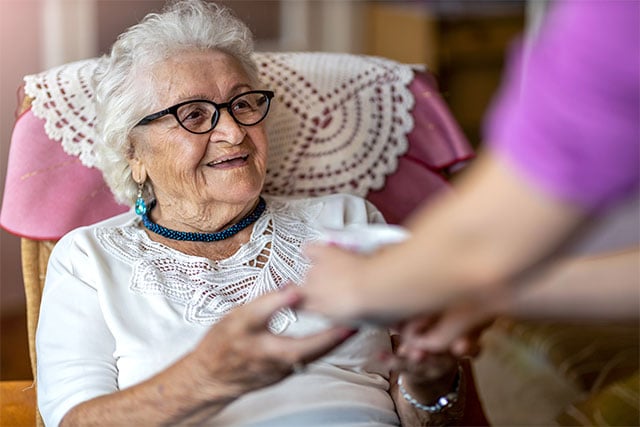
When your loved one requires a new level of support and care, helping them through the transition to memory care is one of the most loving acts you can do. It’s also not something you need to do alone. From identifying the possible signs that they need additional care to explaining the benefits that memory care can have, this article will help show how the transition can have a far-reaching positive impact on the life of your loved one.
Recognizing the Signs and Safety Concerns
Understanding when a loved one would benefit from more care starts by assessing how well they are handling activities of daily living (ADLs), such as grooming, eating nutritiously, drinking enough water, and moving around.
Increasing memory impairment often has unique signs. “As family members, we sometimes see only snapshots,” says Tina V., regional director of life enrichment for The Goodman Group. “Common signs can be when your loved one acts frequently frustrated because things are lost or they repeat the same question like what day it is.”
When a loved one starts demonstrating these behaviors, they are at a higher risk for health concerns like medication mismanagement, dehydration, and malnutrition. It’s also a safety concern. They could accidentally start fires from leaving water boiling or get lost on their way home from a walk or a drive.
“I always think to myself, ‘Are they in a safe environment?’” asks Tina. “If they aren’t, that’s when a move may be the smartest and kindest decision.”
Adapting to a New Place
Many times, individuals hesitate to relocate their loved one from a known environment because they worry that adapting to a new place may accelerate their loved one’s memory impairment.
“That is not the case,” explains Tina. “In our experience, it can be a relief to the person moving because there’s not so much on their plate to manage.”
Individuals living in a memory care community do not need to worry about planning or cooking their meals, tending to their home and yard, or going outside and being worried they might not find their way back. Instead, they can focus on fun activities and even specialized programming like skills-based cognitive coaching to improve their overall cognitive health.
Many seniors living at home may struggle with issues of isolation and anxiety. Similar to senior living communities, one of the most significant improvements of living in a memory care community is making friends. “They won’t be alone,” says Tina. “They don’t have to be worried about someone being there if they need something. Our team members are trained to support them.”
Filling Communities with Meaning and Purpose
Moving to a memory care community also offers a wide range of activities within the walls of the community and beyond. Team members at communities managed by The Goodman Group meet with family members to learn everything they can about a new resident before they arrive. It helps the team identify opportunities for the resident to become involved in the community.
“Our team works where the residents live,” says Tina. “We know that this is their home, and they get to decide how they want to spend their days. We want to know what brings them joy and what makes them have a good day.”
Oftentimes, this leads to ideas within the community for programming that allow residents to work together for a common cause through activities and committees -- from joining a choir to making homemade dog toys for the local animal shelter.
“One of our committees wanted to raise money to buy diapers and formula to donate to a women’s shelter,” says Tina. “Every week they put on a bake sale to raise the money. They purchased the donations and delivered those gifts.”
Enhancing Quality of Life
These levels of support, engagement, and collaboration can positively impact your loved one’s behavior.
“A lot of family members tell us ‘I didn’t know they could do that,’” Tina says. “They see how residents support each other and say, ‘I’m so happy my mom is part of a community.’”


